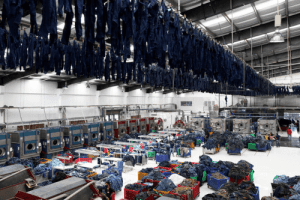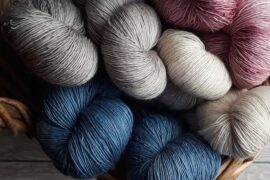How are Jeans made?
Although the manufacturing process of jeans may consist of a number of steps and tasks, it may widely be divided into four basic ones.
- Pattern Making
- Cutting
- Sewing
- Finishing
As already discussed the denim jeans were initially made to be worn as a work overall. The three things that were important for its acceptance were comfort, durability, and sturdiness. As of today even, jeans is considered as one of the most comfortable and leisure apparel in the fashion world.
Pattern Making and Plotting
The pattern of the jeans is often made in collaboration with a designer. Traditionally done on a piece of paper with a pencil, in today’s technological era, various software and computer programs may be used for this process. It is like creating the basic anatomy of the product.
The design, the fit, and comfort level, all are dependent on this pattern of the jeans.
The patterns are drawn or traced on the layers of the denim fabric spread out on a surface. In the traditional jeans artisan set up, the tailor would mark each and every denim jeans separately.
But in a factory setting the production is done in bulk. The number of layers will depend on the order being produced by the manufacturer. In most cases, the plotter machine is used for drawing this selected pattern of the jeans on the laid down layers of fabric.
Cutting
Traditionally the expert tailor would use a scissor to cut through various patterns on the denim. But when manufacturing is done in a factory setting very sharp and precise fabric cutters are used to pave their way through these patterns plotted on the fabric spread out in multiple layers.
Stitching
The stitching department welcomes the denim cut parts and places them in order of sequence as per the stitching process. For some orders, the cuts may require a prior process of digital printing or embroidery. If this is not the requirement, then the stitching process may start right away.
The process is streamlined into a chain production system, where several operators carry out different tasks and functions in a sequential manner.

The style, shape, and fitting of the end product is mainly dependent on the pattern and stitching on the jeans.
The sewing machines utilized in the process are specialized for coping with the high density and thick fabrics like denim. Their components like the needles, threads, and system mechanics are also designed and developed keeping in view the heavy-duty sewing requirements for stitching secured seams with strengthened stitches that can withstand large amounts of stress without easy wear and tear.

Finishing
The stitched jeans go through a process of washing before the final finishing. The washing is divided into two phases as well.
The first is a dry step that involves things like sandblasting, distressing, and tie and dye effects. This is followed by stone washing to make the jeans softer and wearable.

Different types of enzymes and chemical agents are used to create effects like grains, stripes, wrinkles, and waves. These are finally held under high temperatures of an oven or kiln to make the effect long-lasting.
The buttoning, mending, or cropping is done right at the end of the stitching process.
The final product is tagged, pressed, quality checked, and packed for final delivery to the client.
How to make holes and tears in the jeans?
The ripped jeans look can be created by two basic techniques.
- By laser cutting
- By hand
The laser cutting technique is a popular and cost-effective way of creating holes and ripped tears in your jeans. It is mostly adopted in factories where large quantity and bulk orders are manufactured for clients.
A commonly used laser cutting machine in the jean industry is the Laser Sharp Denim HD Abrasion System. It is a 2500 watt powerful cutter that targets the laser beams on to the secured jeans product and burns down the point of impact creating a hole. The pattern of the hole is already programmed into the machine through a simple user-friendly software program.

This technique is known for its accuracy and precision of laser burning and is ideal for creating intricately designed patterns and styles. It is a fast and quick process and may take less than a minute on each pair of jeans.
The hand ripping technique is more popular and common in manufacturing customized jeans in lesser numbers especially those by designers and fashion enthusiasts.
Each pair of jeans requires special attention from an expert individual who can carefully rip and create the required look even if it takes several minutes and even hours.
The abrasions, cuts or holes are made using specialized cutters which are actually blunt. It is this characteristic of theirs which makes the tears look very natural.
A tool called the Dremel is also quite popular in grinding holes in the jeans with its sandpaper equipped round head.
Threads are then pulled out by hand and tools to create the required ripped look.
The origin of the fashionable and evergreen jeans dates back to the 1800s when it was worn for the very first time. Little did the inventor know that one day it will become the most popular piece of fashion apparel in the entire world.
Evolving through almost 200 years of history, the denim jeans have come a long way. Initially, it was adopted as a rugged and rough attire for the miners located in the American West. However, later on, it became fashion frenzy for rock stars, musicians, Hollywood celebrities, world-famous fashion icons and not to forget the cowboys from the wild wild west.
Even after passing through a historic period of two centuries, jeans remain the most popular denim attire in the world. With a large number of variations, it ranges from skinnies to bell bottoms, stretchable and loose fits, and any other style that you can think of.
Jeans remain equally popular in the young and the old and the men and the women. Its popularity flourishes without any limitation to ethnicity, culture, or geographic borders.
Who Invented Jeans?
The word “Jeans” was initially adopted for an informal pair of trousers made from twill cotton cloth. The origin of this name starts from a small city in Italy called Genoa. It was the birthplace for the material known as cotton corduroy and referred to as Jean or Jeane in Italian.
Although blue cotton pants and dungarees were commonly used even before the 1800s as work overalls in many industries across the globe, the very first pair of jeans were invented in the USA by Levi Strauss and Jacob Davis in 1873.
Strauss was a German who had come to America to join his brother’s business of dry goods. It was in 1853 when he started his work in San Francisco right in the time of the Western Gold Rush. Cotton twill cloth was one of the many things that he traded in his business.
Davis was a seasoned tailor originating from the city of Reno in Nevada. He specialized in making horse blankets, wagon covers, and basic tents.
It was in 1873 that Jacob stitched his first customized pair of jeans for a client who wanted a sturdy and durable set of trousers that he could wear to his work without the fear of ripping down his pockets or pants.
Jacob made this historical informal trouser using strong and sturdy denim bought from Levies Strauss and Co. He added the required strength in this rugged piece of work attire by using copper rivets on the most stressed areas of the pants like the fly and pocket areas.
Once it became highly popular among the gold miners of the region, he added a Levi Strauss label at the back of the jeans to patent it. The partnership was unavoidable because there would be no jeans without its sturdy cotton material sold by Levi Strauss.
What Materials are used to Make Jeans?
Jeans are made from a durable and sturdy material known as Denim. Most of the jeans manufactured worldwide are made from this twill cotton cloth but you can also find variations and modifications in designs, colors, and materials.
What is Denim?
It is the blueprint material of the original Levi Strauss Jeans that was ready to make history.
The material called denim is a very strong type of cloth used primarily for making jeans. Its generic name, Serge de Nimes, has been derived from its place of origin in France called Nimes. Therefore it is called “de Nimes” or denim.
In those times the city of Genoa in Italy was famous for its clothing material called cotton corduroy. The expert weavers in Nimes were given the task of replicating this material in their hometown.
However, over a period of several trial and error incidents, instead of creating cotton corduroy they came up with their own original twill fabric which they decided to call denim.
This denim material is a very strong twill fabric that is characterized for its long life and durability even in the toughest of working environments.
Being 100% cotton, in essence, it is a naturally produced material which is comfortable and breathable. It is weaved into a thick twill fabric making it resistant to wear and tear and abrasions of different kinds. It is easily washable and can be patched if required.
This was the material that Jacob Davis bought from Levi Strauss and Co. and chose to make his first pair of jeans.
Why are Jeans blue?
Indigo dye is used for this blue color in the fabric used for making jeans. It is woven in a way in which the white weft is passed under a couple or more of indigo dyed warp threads. As a result, the fabric produced gives the shaded blue and whitish color to the denim.
We have been seeing the blue color of the jeans since forever. In the older times, the blue color of the denim was a symbol of distinguishing the blue-collar workers from others. However, over the years the same colored jeans was worn by people from almost all walks of life.
From the very first day, the indigo organic dye was used by the weavers in Nimes. This was the only color easily available to them in those days.
Originating from the Indian Subcontinent, the indigo name was derived accordingly. This dye was originally extracted from Indigofera Tinctoria, a botanical plant in India. It was famously and commonly used in various parts of the world for dying cotton because of its low cost and simple dying process.
A key characteristic of this organic dye was that instead of penetrating the cotton-like all other regular dyes, its molecules attached themselves to the surface of the cotton fibers.
With each wash of the jeans, some of the dye particles are washed away, resulting in the faded outlook of the jeans which has become a fashion symbol.
As time passed and the denim evolved into the industrial era, manufacturers replaced the organic dye with the synthetic indigo color. Artificial processes were adopted to produce the faded and the ripped signature denim jeans.
Where do jeans come from?
The original denim used for manufacturing jeans is a 100% cotton material. Although with various modifications and variations, other synthetic materials are also being used, the importance of cotton denim cannot be faded out.
The fabric starts its journey from fibers that are grown on plants coming from cotton seeds. Handpicked from fields, the fibers are removed and separated to be packed into bales.
These bales are moved to manufacturing factories where carding of the fibers is carried out and long strands are produced. The strands then undergo a spinning process that changes them into yarns that are spun on spools for final use.
While producing denim, the cotton yarn is turned blue by dying with indigo color. Some manufacturers may defer the dying process and pursue it once the fabric has been woven.
The weaving process of the fabric is also very unique where two or more warp threads pass through each weft thread. This is what gives the denim fabric its iconic weave outlook of the diagonal lines.
The raw form of denim is ready right after the weaving and dying is done. Because it is a hard and sturdy material some manufacturers may pass the raw denim through a process called stone washing. This makes it’s a little softer and wearable for the consumers.
To sum it up
The fashion industry will be incomplete without this amazing piece of garment. No other apparel has achieved this much acceptance worldwide without any demographic or geographic barriers. Looking for denim jeans manufacturers? Check these articles about jeans manufacturers in China, Pakistan, and Bangladesh.





1 Comment
Pingback: Fabric Manufacturing Process: Complete Guide - Fashion Manufacturing